Fausto Zonaro
Paintings
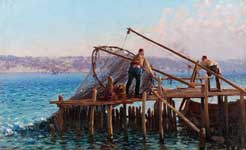
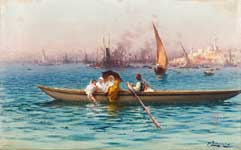
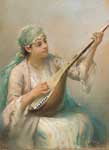
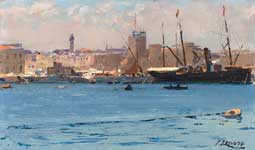

Mehmed II at the siege of Constantinople
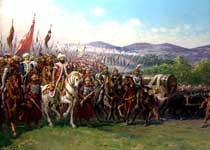
Mehmet II conquering Constantinople
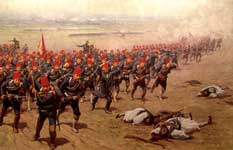
The Attack
Buy Fine Art Prints | Greeting Cards | iPhone Cases
Fausto Zonaro was an Italian painter.
Life
Young life and early art career
Fausto Zonaro was born in Masi, a municipality in the Province of Padua, in what was then the Austrian Empire, in 1854. He was the eldest child of the mason Maurizio Zonaro and his wife Elisabetta Bertoncin. Maurizio Zonaro intended that his son Fausto should follow him in his profession. Fausto Zonaro however, showed a great ability at drawing even at a very young age.[2]
So, with his parents’ consent, he was enrolled in the Technical Institute in Lendinara and after that in Verona at the Academy of Fine Arts run by Napoleone Nani. Later he opened a small art school in the city of Venice, but his work often caused him to spend time in Naples as well. He felt no clear direction in his life at that time.
The turning point in Zonaro’s career occurred however in 1891, when, together with Elisabetta Pante, his former Venetian pupil who he had fallen in love with, he decided to travel with her to the capital of the Ottoman Empire, Constantinople, now known as Istanbul. They were partly inspired to make this trip by having read Edmondo de Amicis’ travel book Constantinopoli.[2]
Constantinople
Il reggimento imperiale di Ertugrul sul ponte di Galata (The Imperial Regiment of the Ertugrul on the Galata Bridge)
In 1892 Zonaro and Pante married, and lived in the part of Constantinople known as Pera. In Constantinople, over time he came to the attention of the aristocratic circles, and obtained from them orders for his works.
One of these was Teşrifat Nazırı Münir Paşa who invited him to visit Yıldız Palace and meet the prestigious Ottoman artist Osman Hamdi Bey. He was then employed in teaching painting to the wife of Münir Paşa, and in this way Zonaro and his wife, got to know the important artistic figures of Constantinople of that time. In 1896 he was nominated as the court painter (Ottoman Turkish: Ressam-ı Hazret-i Şehriyari) thanks to the intervention of the Russian ambassador who had presented the ruling sultan Abdulhamid II with Zonaro’s work Il reggimento imperiale di Ertugrul sul ponte di Galata (in English: The Imperial Regiment of the Ertugrul on the Galata Bridge), which Abdulhamid II had then purchased.
This painting is of the crew of the Ottoman warship Ertugrul which had just been sent off on a visit to Japan. The Sultan later requested that Zonaro, as court painter, paint other works for him, in particular a series of paintings depicting the time of the 15th-century Ottoman sultan, Mehmed II.
Holding the position of court painter, Zonaro viewed himself as the successor to the Venetian painter Gentile Bellini, who had been commissioned by Mehmed II to paint his portrait over 300 years earlier.[3]
Return to Italy and death
Zonaro remained in Constantinople until 1909, when he returned to Italy following the coup d'état that had overthrown his patron Abdulhamid II. There would be no other Ottoman court painter after him.[2] He settled in Sanremo where he continued to paint small works depicting the Italian Riviera and the nearby French Riviera until his death.
In 1920 he separated from his wife and began living with his daughter. Nine years later, he died. He is buried in the Foce Cemetery in Sanremo. On his gravestone, underneath an Ottoman tughra, it states that Zonaro was the court painter of the Ottoman Empire.[4]
Artistic work and reputation
Zonaro painted portraits, landscapes and historical paintings. It is claimed that “Zonaro was one of those who made a major contribution to the development of western style art in Turkey.”[4] He was a prolific artist who created hundreds of works, most of which are of the Ottoman Empire. An exhibition of his work in Florence in 1977 "received wide acclaim in the art world".[4]
Today, the majority of Zonaro’s works remain in Istanbul, and many of them are on display in the city’s leading museums. His pictures can be found in the state museums of Topkapı Palace, Dolmabahçe Palace and the Istanbul Military Museum. Zonaro’s works can also be found in the private Sakıp Sabancı Museum[5] and Pera Museum. Also, a number of them belong to private collectors in Turkey.[4]
Artist from Italy
Text is available under the Creative Commons Attribution-ShareAlike License
